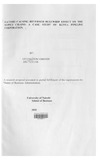| dc.description.abstract | The study sought to determine the factors that cause supply variability along the supply chain of organisations. The study location was Kenya Pipeline Company, Kenya where from a population of 7 depots, purposive sampling was used to select a sample of 5 depots. Data was collected through the use of questionnaires with both open and closed ended questions to capture the qualitative and quantitative characteristics of the pipeline operations. Descriptive survey and a case study research design that encompasses both quantitative and qualitative methods to collect and analyse data were utilized. The findings suggested that capacity constraint was the major factor contributing to supply chain inefficiency.The conclusion was that the supply chain was inefficient because of capacity challenges and government intervention. Recommendations included capacity adjustment strategies, equipment upgrade, additional man and machine hours, reliable source of power and a non-disruptive government interventio | en |

